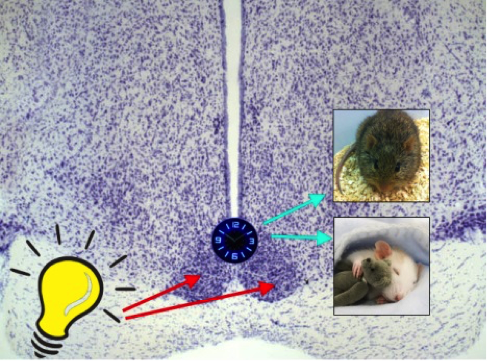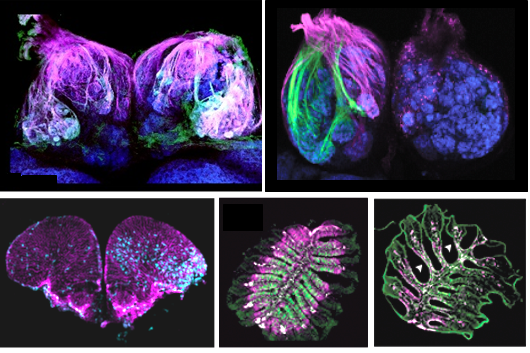Research
Our program strongly promotes discovery and inquiry-based learning through our research projects in courses and in faculty research labs.
Neuroscience may be an undergraduate minor, but you will learn to research like a
graduate student. All three core classes in the neuroscience program incorporate research
and lab work. In addition, many of the flagged courses offered through our sister
departments as part of the program emphasize research related to biology, chemistry,
engineering, mathematics, nursing, philosophy and psychology.
In the capstone course, students are expected to develop their own research hypotheses,
write a scientific research proposal, complete the experiments and report their results
both orally and in writing. You’ll work on a semester-long project focused on identifying
risk factors for the development of mood disorders. Students present these research
projects at the annual Celebration of Undergraduate Research and Creative Performance at Hope College, national scientific conferences like the Society for Neuroscience Annual Meeting and regional meetings such as the Midwestern Psychology Association annual meeting. Portions of these papers have also been submitted for publication
with students as co-authors.
Student/Faculty Collaborative Research Opportunities
All of our faculty are actively pursuing research in their fields and much of it is directly related to neuroscience. Topics include:
Affective Neuroscience
- Dr. Root Luna
 Dr. Root Luna and her students explore the connections among emotion, virtues (like forgiveness,
gratitude, hope and humility), mental health and physiology. Specifically, Dr. Root
Luna's work centers on the peripheral nervous system, examining facial muscles, sweat,
respiration, heart rate, blood pressure and heart rate variability (a measure of parasympathetic
nervous system engagement). In the lab, participants are often asked to engage in
imagery paradigms, cognitive tasks or writing while their physiology is monitored.
Overall, this work is designed to bring clarity to the question of how our emotions
and character influence both our mental health and physiological functioning.
Dr. Root Luna and her students explore the connections among emotion, virtues (like forgiveness,
gratitude, hope and humility), mental health and physiology. Specifically, Dr. Root
Luna's work centers on the peripheral nervous system, examining facial muscles, sweat,
respiration, heart rate, blood pressure and heart rate variability (a measure of parasympathetic
nervous system engagement). In the lab, participants are often asked to engage in
imagery paradigms, cognitive tasks or writing while their physiology is monitored.
Overall, this work is designed to bring clarity to the question of how our emotions
and character influence both our mental health and physiological functioning.
Also see research by Dr. Griffin in cellular/molecular neuroscience below.
Systems/Behavorial Neuroscience
- Dr. Gall
-
 Dr. Gall and his students are seeking to understand the neural mechanisms and functions of
sleep and circadian rhythms. Dr. Gall is especially interested in species-differences
in the brain between animals that are diurnal (day-active) and those that are nocturnal
(night-active), and how these differences emerge over development. Currently, Dr.
Gall and his students are examining the mechanisms responsible for supporting a diurnal
profile of activity in species like our own by performing brain lesions in a diurnal
species, the Nile grass rat.
Dr. Gall and his students are seeking to understand the neural mechanisms and functions of
sleep and circadian rhythms. Dr. Gall is especially interested in species-differences
in the brain between animals that are diurnal (day-active) and those that are nocturnal
(night-active), and how these differences emerge over development. Currently, Dr.
Gall and his students are examining the mechanisms responsible for supporting a diurnal
profile of activity in species like our own by performing brain lesions in a diurnal
species, the Nile grass rat. - Dr. Chase and Dr. Barney
-
 Bipolar disorder and other psychiatric disorders affect millions of people worldwide
and can have devastating effects on relationships and the quality of life. Animal
models of psychiatric disorders are needed in order to learn more about possible causes
of these problems and test novel therapies. The laboratories of Dr. Chase and Dr. Barney are collaborating on the development of a new animal model of bipolar disorder using
rats treated soon after birth with either the neurotoxin homocysteic acid or precursors
of homocysteic acid. Following weaning and further growth, the rats are tested for
behavioral, physiological and neurochemical alterations that may be similar to those
seen in bipolar disorder.
Bipolar disorder and other psychiatric disorders affect millions of people worldwide
and can have devastating effects on relationships and the quality of life. Animal
models of psychiatric disorders are needed in order to learn more about possible causes
of these problems and test novel therapies. The laboratories of Dr. Chase and Dr. Barney are collaborating on the development of a new animal model of bipolar disorder using
rats treated soon after birth with either the neurotoxin homocysteic acid or precursors
of homocysteic acid. Following weaning and further growth, the rats are tested for
behavioral, physiological and neurochemical alterations that may be similar to those
seen in bipolar disorder.
Also see research by Dr. Calvo-Ochoa in cellular/molecular neuroscience below.
Cellular/Molecular Neuroscience
- Dr. Griffin
-
 Dr. Griffin and his students investigate how microbes interact with the nervous system. In particular,
they are looking at the mechanisms by which neuropeptides affect the viability and
replication of bacteria and viruses. The Griffin lab is also researching how microbial
infections may cause cognitive dysfunction.
Dr. Griffin and his students investigate how microbes interact with the nervous system. In particular,
they are looking at the mechanisms by which neuropeptides affect the viability and
replication of bacteria and viruses. The Griffin lab is also researching how microbial
infections may cause cognitive dysfunction. - Dr. Chase
-
 Dr. Chase and her students strive to understand the regulation of an important membrane transporter
that is highly expressed in astrocytes in the brain. This transporter plays an important
role in maintaining the oxidative health of the astrocytes and the synaptic levels
of the neurotransmitter glutamate. Dysregulation of the transporter can lead to excessive
glutamate release, excitotoxic cell death and/or development of oxidative stress.
They have shown that oxidants acutely regulate the transporter’s activity by triggering
its rapid redistribution from intracellular compartments to the cell surface. Their
goal is to investigate the specific molecular mechanisms which allow for acute regulation
of the transporter and identify key proteins which regulate transporter trafficking.
As such, their work may provide direction for future studies aimed at pharmacological
manipulation of transporter activity for therapeutic benefit.
Dr. Chase and her students strive to understand the regulation of an important membrane transporter
that is highly expressed in astrocytes in the brain. This transporter plays an important
role in maintaining the oxidative health of the astrocytes and the synaptic levels
of the neurotransmitter glutamate. Dysregulation of the transporter can lead to excessive
glutamate release, excitotoxic cell death and/or development of oxidative stress.
They have shown that oxidants acutely regulate the transporter’s activity by triggering
its rapid redistribution from intracellular compartments to the cell surface. Their
goal is to investigate the specific molecular mechanisms which allow for acute regulation
of the transporter and identify key proteins which regulate transporter trafficking.
As such, their work may provide direction for future studies aimed at pharmacological
manipulation of transporter activity for therapeutic benefit. - Dr. Erika Calvo-Ochoa
-
 The Calvo lab investigates mechanisms of brain plasticity, repair and regeneration
following damage and disease in the adult brain of zebrafish. The lab studies the
olfactory system of zebrafish, given its remarkable regenerative abilities and the
possibility of studying olfactory-mediated behaviors. In particular, Dr. Calvo-Ochoa
and her students explore how brain lesions and neurodegenerative diseases modulate
inflammation and regenerative responses, and how these processes affect olfactory
function and behavior.
The Calvo lab investigates mechanisms of brain plasticity, repair and regeneration
following damage and disease in the adult brain of zebrafish. The lab studies the
olfactory system of zebrafish, given its remarkable regenerative abilities and the
possibility of studying olfactory-mediated behaviors. In particular, Dr. Calvo-Ochoa
and her students explore how brain lesions and neurodegenerative diseases modulate
inflammation and regenerative responses, and how these processes affect olfactory
function and behavior.
Also see research by Dr. Chase and Dr. Barney in systems/behavioral neuroscience above.
Applied neuroscience
- Dr. Goris
- Dr. Goris has established a nurse-led molecular genetics laboratory at Hope College, and her research is focused on the relationship between neuropsychiatric symptoms and genetics in people with Alzheimer's Disease. She is working with students to explore various genes hypothesized to be involved in the biologic pathway underlying apathy, with genetic variation playing a significant role in differential apathy symptoms, in an effort to contribute to decreasing apathy and improving quality of life among individuals with Alzheimer's Disease suffering from neuropsychiatric symptoms.
- Dr. Polasek
 Dr. Polasek and her students are working toward designing a non-invasive, home-based therapy
for treating phantom limb pain using electrical stimulation. In particular, better
methods to activate nerves from the surface of the skin are being developed. Computer
models are used to make initial predictions of effective electrode locations that
are then tested on people with and without amputated limbs.
Dr. Polasek and her students are working toward designing a non-invasive, home-based therapy
for treating phantom limb pain using electrical stimulation. In particular, better
methods to activate nerves from the surface of the skin are being developed. Computer
models are used to make initial predictions of effective electrode locations that
are then tested on people with and without amputated limbs.
If a particular topic interests you, talk to your professor about ways to participate. There are typically opportunities every year for students to collaborate with faculty on original research.
A. Paul Schaap Science Center35 East 12th StreetRoom 3106AHolland, MI 49423
workP. 616.395.7729
neuroscience@hope.edu